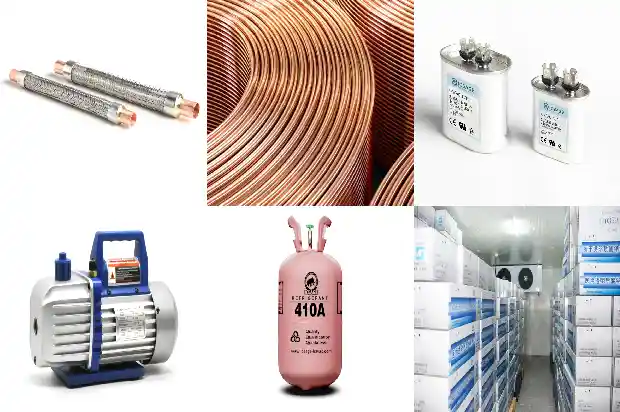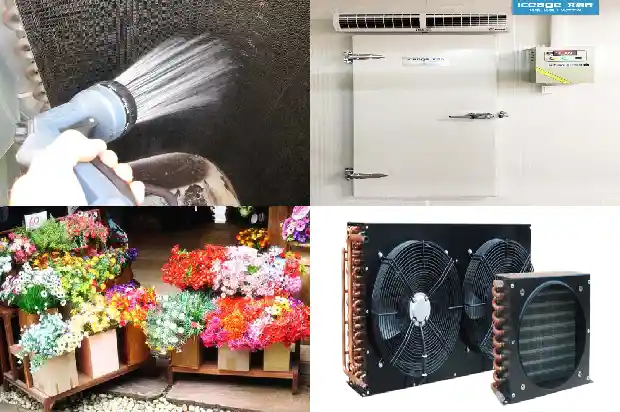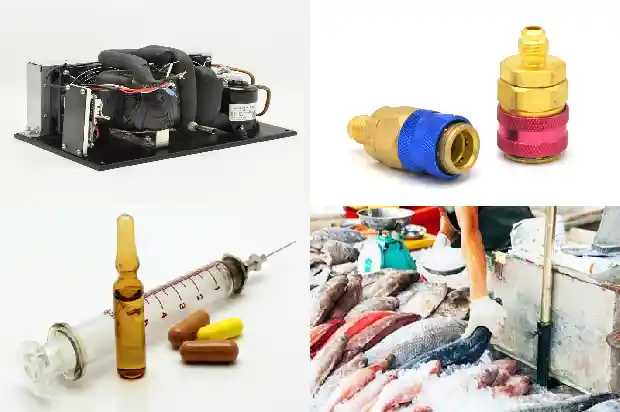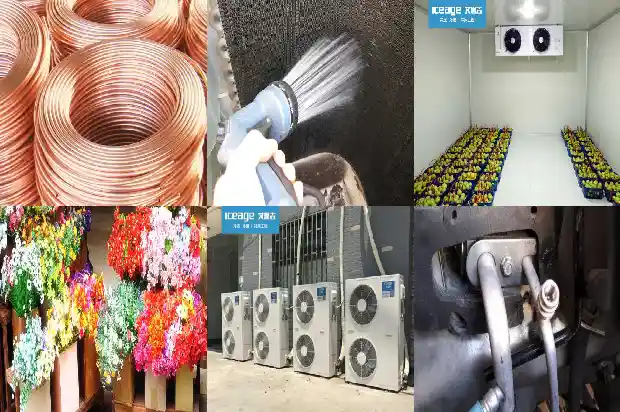Estimation of Temperature and Pressure in the Refrigeration System
2025-03-09
The balance pressure, high-pressure, and low-pressure are important parameters in air conditioner maintenance. These three pressures are the pressures corresponding to the refrigerant at different positions during its circulation in the air conditioner pipeline.

The balance pressure refers to the pressure when the high and low pressures are balanced when the compressor is not in operation; the high-pressure refers to the discharge pressure or condensing pressure; the low-pressure refers to the suction pressure or evaporation pressure. The measurements of these three pressures are all taken at the process port of the gas valve of the outdoor unit. During the cooling operation, it is the low-pressure, during the heating operation, it is the high-pressure, and when not in operation, it is the balance pressure.
Condensing Pressure and Condensing Temperature:
The condensing temperature refers to the saturation temperature when the refrigerant vapor in the condenser condenses under a certain pressure. The condensing temperature is not equal to the temperature of the cooling medium, and there is also a heat transfer temperature difference between the two.
The condensing pressure is the pressure at which the refrigerant condenses from a gas to a liquid in the condenser. Since the pressure inside the condenser in the refrigeration system cannot be measured, and in fact, the pressure drop of the refrigerant in the exhaust pipe and the condenser is actually very small, so whether it is in the design, debugging, or maintenance process, it is generally considered that the discharge pressure is approximately equal to the condensing pressure.
The condensing temperature refers to the saturation temperature when the refrigerant vapor in the condenser condenses under a certain pressure. The condensing temperature is not equal to the temperature of the cooling medium, and there is also a heat transfer temperature difference between the two.
The condensing pressure is the pressure at which the refrigerant condenses from a gas to a liquid in the condenser. Since the pressure inside the condenser in the refrigeration system cannot be measured, and in fact, the pressure drop of the refrigerant in the exhaust pipe and the condenser is actually very small, so whether it is in the design, debugging, or maintenance process, it is generally considered that the discharge pressure is approximately equal to the condensing pressure.

The Relationship between Condensing Temperature and Condensing Pressure:
The condensing pressure and the condensing temperature correspond to each other; the lower the condensing pressure (high pressure), the lower the condensing temperature; the higher the condensing pressure (high pressure), the higher the condensing temperature.
The condensing pressure and the condensing temperature correspond to each other; the lower the condensing pressure (high pressure), the lower the condensing temperature; the higher the condensing pressure (high pressure), the higher the condensing temperature.
Estimation of Condensing and Evaporation Temperatures
When debugging refrigeration equipment, we often need to know the condensing temperature, and then further calculate the condensing pressure (high pressure or discharge pressure). Then, according to the actual pressure, we can determine whether there is a problem with the refrigeration system.
Reference of Empirical Estimation Values: Condensing temperature = Ambient temperature/Water temperature + (10~20℃);
Example: For a water chiller, given that the outlet water temperature of the cooling tower is 25 degrees, then the condensing temperature of the refrigeration system at this time: Condensing temperature = 25 + (10~20) = 40℃. According to the temperature-pressure comparison table, it is easy to find that the condensing pressure at this time is 14.2bar (using R22 refrigerant);
When the ambient temperature is high, subtract the higher value (20 or 15); when the ambient temperature is low, subtract the lower value (10℃);
When debugging refrigeration equipment, we often need to know the condensing temperature, and then further calculate the condensing pressure (high pressure or discharge pressure). Then, according to the actual pressure, we can determine whether there is a problem with the refrigeration system.
Reference of Empirical Estimation Values: Condensing temperature = Ambient temperature/Water temperature + (10~20℃);
Example: For a water chiller, given that the outlet water temperature of the cooling tower is 25 degrees, then the condensing temperature of the refrigeration system at this time: Condensing temperature = 25 + (10~20) = 40℃. According to the temperature-pressure comparison table, it is easy to find that the condensing pressure at this time is 14.2bar (using R22 refrigerant);
When the ambient temperature is high, subtract the higher value (20 or 15); when the ambient temperature is low, subtract the lower value (10℃);
The Relationship between Condensing Temperature and Power
When the condensing temperature increases, with the evaporation temperature remaining unchanged, the compression ratio of the compressor increases. And the power of the compressor is directly proportional to the compression ratio, that is, as the compression ratio increases, the power of the compressor also increases.
It can be simply understood as follows: The power required for the compressor to compress 5 kilograms of refrigerant to 15 kilograms is definitely less than the power required for the compressor to compress 5 kilograms of refrigerant to 25 kilograms.
When the condensing temperature increases, with the evaporation temperature remaining unchanged, the compression ratio of the compressor increases. And the power of the compressor is directly proportional to the compression ratio, that is, as the compression ratio increases, the power of the compressor also increases.
It can be simply understood as follows: The power required for the compressor to compress 5 kilograms of refrigerant to 15 kilograms is definitely less than the power required for the compressor to compress 5 kilograms of refrigerant to 25 kilograms.
The Relationship between Condensing Temperature and Refrigeration Capacity
When the condensing temperature rises, the refrigeration capacity of the system will also decrease.
When the condensing temperature rises, the refrigeration capacity of the system will also decrease.

The Relationship between Heat Load and Condensing Pressure
Under a constant working condition (refrigerant flow rate), the greater the heat load, the higher the condensing pressure, and vice versa. We can imagine that when the condenser you designed is small (the heat load is relatively large), the refrigeration system is very likely to trigger a high-pressure alarm.
Under a constant working condition (refrigerant flow rate), the greater the heat load, the higher the condensing pressure, and vice versa. We can imagine that when the condenser you designed is small (the heat load is relatively large), the refrigeration system is very likely to trigger a high-pressure alarm.
Analysis of the Reasons for Abnormal Condensing Temperature
Low Condensing Temperature: There are many reasons for the low condensing temperature. The mechanism leading to the low condensing temperature is that there is less refrigerant in the evaporator or the throttling effect of the throttle valve is not good. The following are listed:
Low Condensing Temperature: There are many reasons for the low condensing temperature. The mechanism leading to the low condensing temperature is that there is less refrigerant in the evaporator or the throttling effect of the throttle valve is not good. The following are listed:
- The expansion valve is oversized in selection;
- The expansion valve is faulty or the opening of the expansion valve is too large, and there is no throttling effect;
- The refrigerant charge in the refrigeration system is insufficient;
- The refrigeration system lacks refrigerant: Points 1 to 2 mainly analyze the throttling effect of the expansion valve, and points 3 to 4 mainly analyze the lack of refrigerant;
High Condensing Temperature:
(1) Small flow rate and high temperature of the cooling water (or air);
(2) There is air in the system, causing the condensing pressure to rise;
(3) Excessive refrigerant charge, with the liquid occupying the effective condensing area;
(4) The condenser has not been repaired for a long time, and the dirt on the heat transfer surface is serious, which can also lead to an increase in the condensing pressure. The presence of scale also has a great impact on the condensing pressure.
Of course, there are many other reasons.
It is recommended to consider from three aspects:
- There is too much refrigerant in the condenser.
- There are other impurities in the refrigeration system, which occupy the heat transfer area of the condenser.
- The condensing effect of the condenser is not good.
Treatment of High Condensing Pressure:
When the condensing pressure rises, the discharge temperature of the compressor also rises. The compression ratio of the compressor increases, and the volumetric efficiency decreases, thus reducing the refrigeration capacity of the compressor. The power consumption increases.
If the discharge temperature is too high, it will increase the consumption of the compressor lubricating oil, make the oil thin, and affect the lubrication; when the discharge temperature is close to the flash point of the compressor oil, it will also cause part of the lubricating oil to carbonize and accumulate at the suction and discharge valve ports, affecting the sealing performance of the valves.
There are two ideas for the treatment methods: - Lowering the temperature of the cooling medium can make the condensing temperature drop, and the condensing pressure will also drop accordingly, but this is limited by environmental conditions and is difficult to be artificially selected.
- Increasing the flow rate of the cooling medium can lower the condensing temperature slightly (this method is mostly used). However, the flow rate of the cooling water or air should not be unilaterally increased, because this will increase the power of the cooling water pump, fan, and motor, and a comprehensive consideration should be made.
A high discharge pressure will increase the compression work and reduce the volumetric efficiency, thus reducing the refrigeration efficiency.
How to Control the Condensing Temperature:
By controlling the inlet pressure of the condenser, the condensing pressure of the condenser can be controlled, because the pressure drop of the condenser is actually very small, and it can be approximately regarded that the inlet pressure is equal to the condensing pressure. So how to control the inlet pressure?
Methods:
By controlling the inlet pressure of the condenser, the condensing pressure of the condenser can be controlled, because the pressure drop of the condenser is actually very small, and it can be approximately regarded that the inlet pressure is equal to the condensing pressure. So how to control the inlet pressure?
Methods:
- Control the air volume flowing through the condenser. When the air volume is large, the condensing pressure will naturally decrease. By controlling the rotation speed of the fan through a frequency converter, it is easy to control the inlet pressure of the condenser;
- Adopt the method of an auxiliary condenser. By controlling the water flow rate or water temperature of the auxiliary condenser, the inlet pressure of the condenser can be further controlled.
Related Articles
- The Influence of Temperature Changes on the Air Conditioning Refrigeration System
- Does a lower evaporation temperature result in a larger refrigeration capacity, or does a higher evaporation temperature lead to a larger refrigeration capacity?
- Cause Analysis of High Discharge Temperature and Overload Protection of Modular Units
- Understand Correctly the Dry-bulb Temperature, Dew-point Temperature and Wet-bulb Temperature
- What Misconceptions Should Be Avoided in Low - temperature Refrigeration System Repairs
- Why Does the Evaporation Temperature of the Refrigeration System Drop Too Low? And Why is the Condensing Pressure Too High?
- Introduction to the Advantages of Dual - temperature Cold Storage
- What are the characteristics of low-temperature cold storage?
- Requirements of Cold Storage Insulation for Maintaining Stable Temperature Inside
- Temperature Gradient Differences between Deep Foundation and Surface of Civil Cold Storage
- Temperature Requirements for Various Cold Storages
- Is the heating effect of air source heat pump air conditioner with enhanced vapor injection really good under low temperature conditions?
- 15 Reasons for Excessive Temperature Rise of Motors
- Types and Temperature Requirements of Seed Cold Storages
- Influence of Condensing Temperature Variation on Vapor Compression Refrigeration System
- Introduction to the Relationship between Refrigerants and Cold Storage Temperatures
- What are the effects of pressure and temperature on the refrigeration system of a cold storage?
- Application of Economizer in Air-cooled Heat Pumps and Low-temperature Screw Compressors
